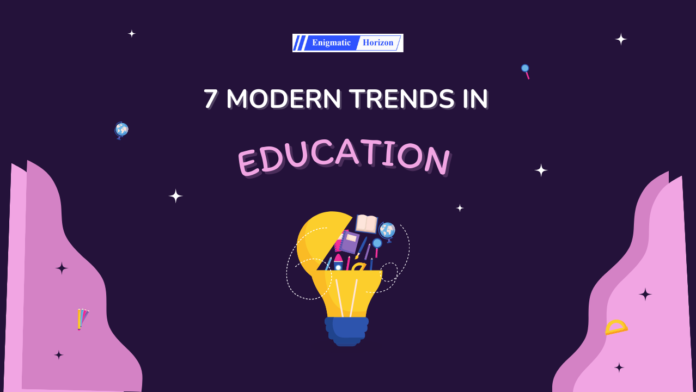“Trend” refers to an overall direction in which a particular area is developing or changing. Now, “trend” is becoming a catchphrase for everyone. Like many other fields such as fashion, economics, social media, the entertainment industry, business, etc., trends are changing in the educational sector as well. In education, trends are highly applicable because of new teaching and learning methods that are bringing great value to people.
One of the most important emerging trends in education is a severe shift from subject-oriented “parrot” learning to a more efficient skill-based learning method. Key skills needed in today’s competitive business environment are cognitive thinking, problem-solving, and management, and for that, a different type of education is an absolute necessity.
The COVID-19 situation directly hit the education scenario and changed it unpredictably. To adapt to the crisis, new concepts evolved in the world of educational trends. While some already existing worldwide trends are ongoing, some are new and futuristic.
We witness changes in trends in almost all fields quite often. And education is one of the areas with a vast potential for change, especially when the COVID-19 crisis challenged the whole world. Some new trends in education have emerged.
Let us have a look at the popular trends in education for now and in the future:
• Online learning: Online learning is a method of education whereby students get to learn in a completely virtual environment. Online learning, also called e-learning, is most prevalent in higher education that enables students from different geographical areas to engage with an academic institution in an online mode. The students get to learn flexibly, at their speed, while studying for a degree or certificate.
• Distance learning: Distance learning refers to a system of education where the teacher and students are not physically present together. High schools and universities offered correspondence courses as a method of distance learning in the past as well, by sending the course materials to the students by mail and accepting their assignments online or by mail. More recently, distance learning programs are making use of the incredible opportunities offered by modern technology which provides very friendly and effective learning opportunities in all manners.
• Blended Learning: Blended learning, also known as hybrid learning, is a method of teaching that combines technology and digital media with traditional instructor-led classroom activities. It gives students more flexibility to customize their learning experiences. In blended learning, some learning is there online in a format in which a student has control over the way and speed at which they engage with content and some learning occurs in an instructor-led classroom. Online and personal learning is balancing, that creates a truly integrated learning environment.
• Personalized Learning: Personalized learning is a learning experience designed for each student with their specific needs. In personalized learning, content, speed, progression, technology, learning models, learning places, audience and any other ‘learning components’ are adjustable according to the knowledge, demand, curiosity, intelligence, and learning purpose of each student.
• Social-Emotional Learning (SEL): SEL is a teaching methodology that helps students of all ages to better understand their emotions fully and demonstrate empathy for others. These learned behaviors are then used to help students make positive, responsible decisions and create a structure to achieve their goals and build positive relationships with others. SEL includes self-awareness, self-management, social awareness, relationship skills and making responsible decisions.
• Homeschooling: Homeschooling is the system of educating children at home instead of sending them to a school or institution. It may be permanent, short-term or on a long-term basis. Children who are homeschooled are taught by homeschoolers who may be their parents or other guardians. It has been noticed that educational quality becomes better in homeschooling as compared to traditional schooling. With more personal care and grooming, home-schooled kids tend to be more interested in studies and they grasp things easier than those in schools because of their more customized routines.
• Gamification and Self Analysis: Gamification in learning aims to make learning fun. Using game-based elements allows students to instantly gather new information and techniques and test that knowledge. The introduction of computer-based design and its inbuilt components can inspire students to develop their skills effectively in an enjoyable way.
In ancient India, both formal and informal ways of education were available. Indigenous education was transmitted at home, in temples, pathshalas, tols, chatuspadis, and gurukuls. The ancient education system of India was very rich. But after the British invaded India, they changed the system of education in the country, which is still running in all educational institutes, and is referred to today as the traditional system. However, this system is highly defective. The major drawback of traditional education is that it is too rigid and does not give enough scope for research and improvement. It places the most value on the students’ academic standards, curriculum, and passing of tests with good grades. Traditional learning is primarily based on the memorization of facts. This system doesn’t promote critical thinking or the ability to actively apply information that is gained through experience and reasoning. Instead, traditional training only focuses on the roles of teachers as knowledge givers and students as receivers. This style of learning doesn’t allow students to go to deeper levels of understanding. It focuses on passing tests, whether the students understand the material or not. So, the students aren’t taught the methods, skills, and techniques they need to find answers. Also, students have fewer chances to practice group dynamics and working as a team because the system tends to focus on individual student work and does not prepare students well for their future endeavors. The modern trends in education should try to resolve most of these issues and help students grow in a better way.
